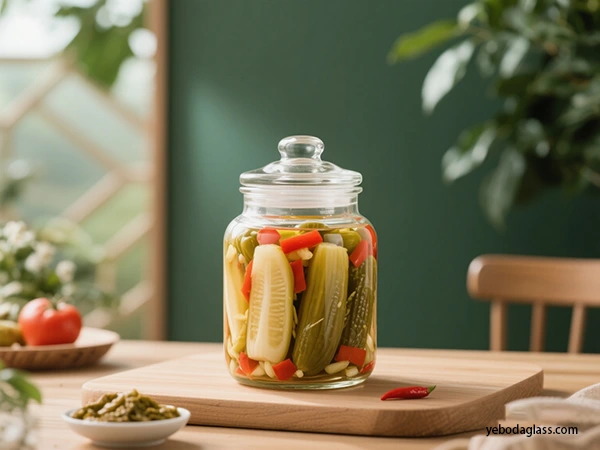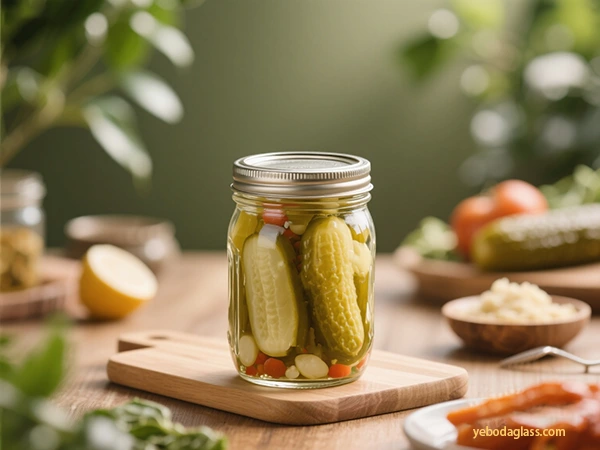介绍
In the fiercely competitive food market, choosing pickle jars for B2B wholesale vendors involves more than just cost calculation. It directly affects the safety and taste of the kimchi, and even influences the brand image in consumers’ minds. After all, the jar is the first thing consumers see when they receive their kimchi, and its quality and appearance influence their purchasing decisions. Therefore, selecting the right pickle jars is an important decision that requires extensive consideration.

Different pickle jars are required for the preparation of separate kimchi
Different kimchi-making methods mainly require specific pickle jars’ characteristics, which mainly focus on heat resistance, sealing, and material.
For High Temperature Kimchi Processing, the Jar Will Have to Face Heat
Processes such as water-bathing canning (suitable for acidic kimchi with pH below 4.6, at temperatures up to 100 ° C) and pressure canning (suitable for kimchi with pH at temperatures of 121–127 ° C) are particularly high demands on heat resistance and thermal shock resistance. The simple soda-laim glass jar has limited heat resistance and is at risk of being cured at high temperatures. Borosilicate glass provides better heat resistance, but it is expensive and less commonly used.
Beware of Cracks During Heat Processing
During heat processing, the jars are most vulnerable to sudden changes in temperature. For example, inserting hot food in a cold jar or keeping a warm jar in a cold place can cause the jar crack. Therefore, it is best to preheat the jar for the same temperature as food before canning, such as soaking them in warm water at about 82 ° C. Also, choose a jar with similar thickness and no scratch or cracks. The 是的,是的。 Kimchi jars provide excellent heat and thermal shock resistance, effectively reduce the risk of cracking during heat processing and ensure safe processing.
Ceiling and Venting Are Important for Refrigerated and Fermented Kimchi
The refrigerated kimchi requires only a tight lid to ensure an airtight seal; No vacuum is required. However, Kimchi Kimchi produces carbon dioxide, which requires a dedicated airlock system for its release while keeping oxygen and contaminated materials out. The Yeboda 泡菜罐 is designed for various production processes. Whether refrigerated or fermented, they ensure a good seal and gas management, which continuously ensure kimchi quality.
The Capacity and Size of the Pickle Jars Are Important
Choosing the right capacity and size can improve production efficiency and ensure the quality of the product.
Capacity Is Not Always Better
The canning does not grow proportionally with time capacity; It depends on the recipe. For example, one half-pint jar and a pint jar can take the same time. It can be dangerous to use a jar larger than the recipe size. When selecting the capacity, consider the size of the batch and, even more importantly, follow the recipe to ensure safety.

Shape Affects User Experience
- Wide-mouthed jar: Wide-mouth jars are suitable for large ingredients, offering easy access and stacking.
- Standard-mouth jars: narrow-mouth jars are suitable for fluid and sauce, as well as small items such as spices.
- Strait-Side Jars: Smooth edges become easier to handle, with adequate labeling space and a wide range of use.
- Long, narrow jars: long, narrow materials such as asparagus and green beans, ideal for pickle. The Yeboda Pickle Jars are available in a variety of abilities and shapes to meet various components and production needs, packaging and more convenient use.
The Sealing System Is the Core of Pickling Jars
The quality of the seal directly determines the shelf life, safety, and taste of the pickled vegetables.
Two-Piece Metal Lids Are Commonly Used for Heat-Treated Canning
This lid consists of a flat metal disc and a spiral ring, creating a vacuum seal during processing and suitable for long-term storage. The disc is disposable, while the spiral ring can be reused if intact.
Airtight and Other Lids for Fermentation
The refrigerated kimchi can be stored using an one-tukra plastic lid, which ensures an airtight seal. Ferred kimchi requires an airlock lid, such as water-seal lid or silicone valve lid, which allows carbon dioxide to block oxygen. Yeboda pickle jars have a well-designed sealing system with reliable sealing performance. which meets various sealing requirements and ensures freshness of kimchi for long periods.
Cost, Durability, and Appearance Should Be Considered Extensively
Wholesale vendors should balance these three factors when selecting the jar, as they affect the overall cost and market competition.
The Durability Depends on the Quality of the Glass
好的 玻璃罐 are thick and high quality, making them durable and shattered. Whereas, they are not temporary glass and still require protection from thermal shock and scratch.
Calculate the Total Cost
Cheap jars can break easily, while more expensive are more durable and may be more cost effective in a long time. Consider the ups and downs in the lifetime and value of the jar.
Appearance Affects Market Appeal
Beautiful jars and creative labels prepare consumers to buy the product better and more. The label design should express the message of the brand and connect with consumers.
Selection of Pickle Jar Supplier: Consider Quality and Reputation
When purchasing from the B2B provider, the brand reputation and quality control of a supplier is important.
Installed Suppliers Are More Reliable
Established brands have proved craftsmanship and guaranteed quality, which inspires the trust. Their jars undergo several tests before leaving the factory, and the anneal increases stability.
Discrimination Between Special Jar and Standard Jar
Commercial food jars (such as mayonnaise jars) are usually unsuitable for pickle jars due to their thin glasses, poor sealing and easy breakdown. Special pickle jars are specially designed to withstand pressure and temperature during processing.

Innovation and Future Approach: Technical Limits of Pickle Jars
With technological progress and changing consumer demands, the design and functionality of the pickle jars are constantly developing. B2B wholesale customers should focus on these innovations to remain competitive and meet market demands for high efficiency, prolonged shelf life and more durable solutions.
Smart Airlock System: Real Time Fersew Monitoring
Traditional fermentation airlocks mainly depend on visual observation of bubble activity to determine fermentation progress, but this method is not always accurate. Emerging “smart” airlock systems, such as Plato digital airlock, integrate the sensor to monitor the major parameters of the fermentation process in real time.
- Data accuracy: These smart devices can accurately count bubbles and estimate specific gravity, fermentation activity and alcohol material based on bubble activity. This provides more scientific and quantitative data support for the fermentation process, which helps producers in better control fermentation results.
- Remote Monitoring: Smart Airlock usually has wireless data transmission capabilities, which send real-time data to smartphone apps for remote monitoring. This means that manufacturers can monitor the state of fermentation and can make timely adjustments without continuous in the fermentation tank.
- DIY Solutions: Even DIY enthusiasts can use projects like iBlopper to connect vibration sensors to traditional airlocks to monitor and record bubble activity. This provides a low-cost smart fermentation solution for small producers.
Advanced Sealing Technology: Beyond Conventional
In addition to traditional two-piece metal lids, new sealing technologies are constantly being developed to improve sealing efficiency and reliability.
- Ultrasonic and induction sealing: These technologies demonstrate greater energy efficiency and enhanced sealing performance in industrial production. Although currently primarily used in industrial packaging, as the technology matures and costs decrease, they may be applied to higher-end B2B kimchi jars in the future.
- Vacuum Sealing: Vacuum sealing expands the shelf life of food by removing the air from the sealing container. For some non-Heat-credited Kimchi or fermented products, vacuum-sequel bags or cans can provide a more intensive ignorant environment, effectively disrupt the growth of aerobic microorganisms.
Non-from Nasal Sterilization Technology: Protecting Taste and Nutrition
Traditional canning methods depend on high temperature sterilization. While it effectively neutralizes microorganisms, it can also cause taste, texture and some damage of nutritional materials. The purpose of emerging non-by-less sterilization technologies is to address the issue.
- Pressed electric field (PEF), ultrasound, cold plasma, and ultraviolet light: These technologies effectively disable microorganisms without significant increase in temperature, making the natural properties of food better. For 150 kimchi products that pursue high end, natural taste and nutritional value, combining these techniques with appropriate packaging materials will be the future development direction.
- Antibacterial packaging: Including natural ingredients such as chitoson and tea polyphenols in packaging films can develop packaging with antimicrobial properties, further expand the shelf life of food.

Permanent Packaging: Environment Protection and Brand Price
Consumers are rapidly concerned about environmental protection, and permanent packaging has become an important way to increase the brand price.
- ISO 14001 and Social Compliance Audit. Kimchi jars and lids are made of recycled materials and can clearly help enhance the brand image labeled with recycling information.
- Risk designs: promoting reusable jars and lids and educating consumers on proper cleaning and maintenance methods can reduce single-use waste and align with the concept of a spherical economy.
- Life cycle evaluation (LCA): A comprehensive life cycle of various packaging materials and systems can help B2B customers to choose solutions with minimal environmental impact.
Personalization and Adaptation: Carrying the Needs of the Niche Market
Along with growing consumer demand for personalized products, B2B clients should also consider offering tailored pickle jar solutions to stay competitive.
- Small-Batch Adaptation: Using technologies like 3D printing, small-batch and custom pickle jar designs can be created to serve specific customer preferences or seasonal offerings.
- Smart Labels: Integrating smart labels with NFC or QR codes enables interactive content such as product traceability, nutritional details, and recipe suggestions, enhancing the consumer experience.
By actively adopting these innovations, B2B wholesale suppliers can not only boost the competitiveness of their pickle jar products, but also build a forward-thinking and trusted brand identity in the market.




